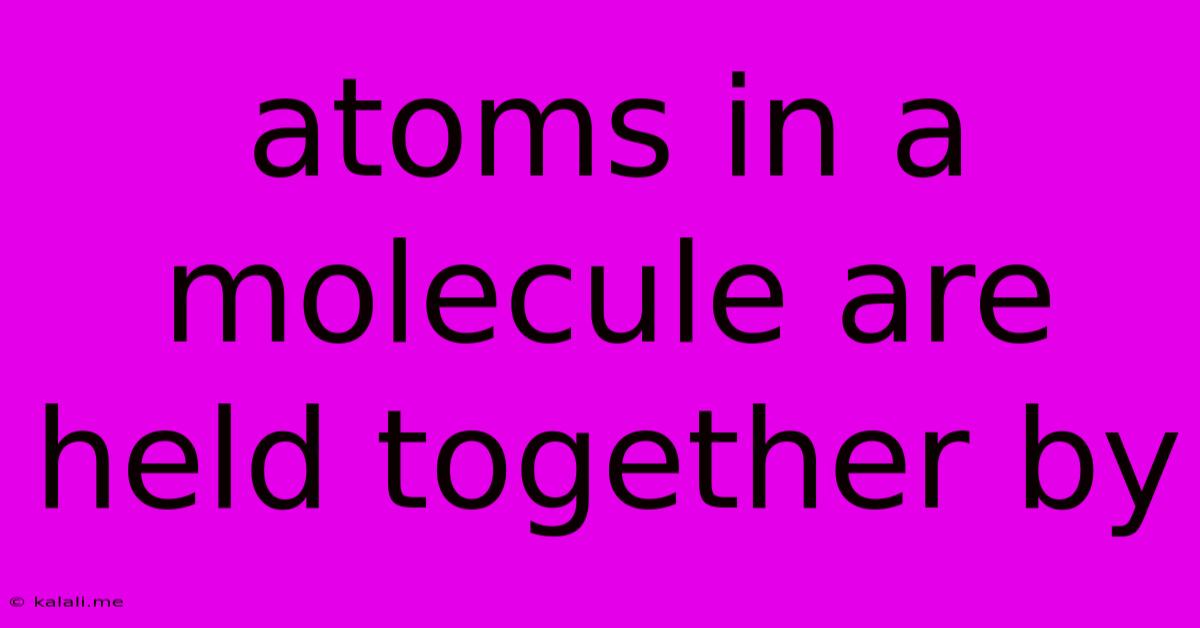Atoms In A Molecule Are Held Together By
Kalali
Jun 14, 2025 · 3 min read

Table of Contents
Atoms in a Molecule are Held Together By: A Deep Dive into Chemical Bonds
Atoms, the fundamental building blocks of matter, rarely exist in isolation. Instead, they tend to combine with other atoms to form molecules, the basis of all chemical compounds. But what force holds these atoms together? The answer lies in chemical bonds, which are powerful attractions that arise from the electrostatic interactions between atoms. This article will explore the different types of chemical bonds, explaining how they work and why they're crucial for the existence of molecules.
The strength and nature of these bonds dictate the properties of the resulting molecule, impacting everything from its melting point and boiling point to its reactivity and overall behavior. Understanding chemical bonds is fundamental to grasping the intricacies of chemistry and the world around us.
Types of Chemical Bonds
Several types of chemical bonds exist, each with its own characteristics and mechanisms. The most common are:
-
Covalent Bonds: These are formed when atoms share one or more pairs of electrons. This sharing allows each atom to achieve a more stable electron configuration, often resembling that of a noble gas (full outer electron shell). Covalent bonds are particularly strong and prevalent in many organic molecules and numerous inorganic compounds. The strength of a covalent bond depends on factors such as the electronegativity of the atoms involved. For example, the bond in a diatomic oxygen molecule (O₂), where two oxygen atoms share electrons, is a strong covalent bond.
-
Ionic Bonds: These bonds form when one atom transfers one or more electrons to another atom. This transfer creates ions: positively charged cations (atoms that have lost electrons) and negatively charged anions (atoms that have gained electrons). The electrostatic attraction between these oppositely charged ions holds them together. Ionic bonds are typically found in compounds formed between metals and nonmetals, such as sodium chloride (NaCl), common table salt. The strength of an ionic bond is influenced by the charges of the ions and the distance between them.
-
Metallic Bonds: These bonds are found in metals. In metals, valence electrons are delocalized, meaning they're not associated with any particular atom but rather move freely throughout the metal lattice. This "sea" of electrons acts as a glue, holding the positively charged metal ions together. Metallic bonds account for the characteristic properties of metals, such as their high electrical and thermal conductivity, malleability, and ductility.
-
Hydrogen Bonds: These are a special type of dipole-dipole interaction. They occur when a hydrogen atom covalently bonded to a highly electronegative atom (such as oxygen, nitrogen, or fluorine) is attracted to another electronegative atom in a different molecule. Hydrogen bonds are weaker than covalent or ionic bonds but play a crucial role in determining the structure and properties of many biological molecules like proteins and DNA. The relatively weak nature of hydrogen bonds allows for easy breaking and reforming, which is essential for many biological processes.
Factors Influencing Bond Strength
The strength of a chemical bond is determined by various factors, including:
-
Electronegativity: The ability of an atom to attract electrons towards itself in a chemical bond. A larger difference in electronegativity between atoms leads to a more polar bond (in covalent bonds) or a stronger ionic bond.
-
Bond Order: The number of electron pairs shared between two atoms in a covalent bond. Higher bond order generally correlates with stronger bonds.
-
Atomic Size: Smaller atoms generally form stronger bonds due to greater overlap of atomic orbitals.
-
Bond Length: The distance between the nuclei of two bonded atoms. Shorter bond lengths usually indicate stronger bonds.
Understanding the types of chemical bonds and the factors that influence their strength is crucial for comprehending the behavior of matter at the molecular level. From the formation of simple molecules to the complex interactions within biological systems, chemical bonds are the fundamental forces shaping our world.
Latest Posts
Latest Posts
-
What Is The Scientific Name Of The Dog
Jun 14, 2025
-
Consider The Following Data For Chromium
Jun 14, 2025
-
Which Of The Following Represent Isotopes
Jun 14, 2025
-
How Many Brick Are In A Cube
Jun 14, 2025
-
A Centrifugal Switch Is Used In A
Jun 14, 2025
Related Post
Thank you for visiting our website which covers about Atoms In A Molecule Are Held Together By . We hope the information provided has been useful to you. Feel free to contact us if you have any questions or need further assistance. See you next time and don't miss to bookmark.